Abstract
Convolvulus pluricaulis Choisy (C. pluricaulis) is a perennial herb that seems like morning glory. All parts of the herb are known to possess therapeutic benefits. The plant is used locally in Indian and Chinese medicine to cure various diseases. It is used in Ayurvedic formulation for chronic cough, sleeplessness, epilepsy, hallucinations, anxiety etc. Based on the comprehensive review of plant profile, pharmacognosy, phytochemistry, pharmacological and toxicological data on the C. pluricaulis, there will be more opportunities for the future research and development on the herb C. pluricaulis. Information on the C. pluricaulis was collected via electronic search (using Pub Med, SciFinder, Google Scholar and Web of Science) and library search for articles published in peer-reviewed journals. Furthermore, information also was obtained from some local books on ethnopharmacology. This paper covers the literature, primarily pharmacological, from 1985 to the end of 2012. The C. pluricaulis is an important indigenous medicine, which has a long medicinal application for liver disease, epileptic disease, microbial disease, cytotoxic and viral diseases, central nervous system (CNS) disease in Ayurvedic medicine, traditional Chinese medicine and other indigenous medical systems. The isolated metabolites and crude extract have exhibited a wide of in vitro and in vivo pharmacological effect, including CNS depression, anxiolytic, tranquillizing, antidepressant, antistress, neurodegenerative, antiamnesic, antioxidant, hypolipidemic, immunomodulatory, analgesic, antifungal, antibacterial, antidiabetic, antiulcer, anticatatonic, and cardiovascular activity. A chemical study of this plant was then initiated, which led to the isolation of carbohydrats, proteins, alkaloids, fatty acids, steroids, coumarins, flavanoids, and glycosides as active chemicals that bring about its biological effects. A series of pharmacognostical studies of this plant show that it is a herb, its stem and leaves are hairy, more over it has two types of stomata, anisocytic and paracytic. A herb, C. pluricaulis has emerged as a good source of the traditional medicine for the treatment of liver disease, epileptic disease, microbial disease, cytotoxic and viral diseases, and CNS disease. Pharmacological results have validated the use of this species in traditional medicine. All the parts of the herb are known to possess therapeutic benefits. Expansion of research materials would provide more opportunities for the discovery of new bioactive principles from C. pluricaulis.
Keywords: Convolvulus pluricaulis Choisy, Pharmacognosy, Microscopy, Macroscopy, Phytochemistry, Pharmacology
1. Introduction
In the last few years, there has been an exponential growth in the field of herbal medicine, and these drugs are gaining popularity both in developing and developed countries because of their natural origin and less side effects[1]. Early humans recognized their dependence on nature for a healthy life, and since that time humanity has depended on the diversity of plant resources for food, clothing, shelter, and medicine to cure myriads of ailments[2]. Shankhpushpi of the Ayurvedic pharmacopeia of India consists of the whole plant of Convulvulus pluricaulis Choisy (Convolvulaceae) syn (C. pluricaulis) and Convulvulus microphyllus Sieb. ex Spreng (C. microphyllus)[3]. Plants other than C. pluricaulis use the name Shankhpushpi in different parts of the country. These include Evolvulus alsinoides Linn, Clitoria ternatea Linn and Canscora decussata Schult.
Indian Council of Medical Research has given quality standards for C. pluricaulis drug in its publication[4]. Although these plants proved their scientific potential in central nervous system depression, anxiolytic, tranquillizing, antidepressant, antistress, neurodegenerative, antiamnesic, antioxidant, hypolipidemic, immunomodulatory, analgesic, antifungal, antibacterial, antidiabetic, antiulcer, anticatatonic, and cardiovascular activity. These are reported to contain several types of alkaloids, flavanoids, and coumarins as active chemicals that bring about its biological effects[5].
The plant has been found to be effective in reducing different types of stress including psychological, chemical and traumatic. The ethanolic and methanolic extracts of the whole plant reduced spontaneous motor activity, potentiated pentobarbitone hypnosis and morphine analgesia, reduced fighting response, abolished the conditioned avoidance response, antagonized convulsive seizures and tremorine induced tremors in mice. The juice of whole plant prevents excessive menstruation. The fine paste made by grinding the plant is helpful to cure abscess. Ethanolic extract of whole plant when administred to cholesterol fed gerbils, reduced serum cholesterol, Low density lipoprotein cholesterol, triglycerides and phospholipids significantly after 90 d. The root extract of this plant regulated hyperthyroidism in female mice. The juice of fresh whole plant of C. pluricaulis possessed anti-ulcerogenic effect and is comparable to sucralfate. Ethanolic extract of the entire plant exerted a negative inotropic action on amphibian and mammalian myocardium. It also exerted spasmolytic activity on smooth muscles[6].
1.1. Plant profile and synonyms
Figure 1 shows the profile of this plant, and the synonyms of this plant include C. pluricaulis and C. microphyllus[7].
Figure 1. C. pluricalis.
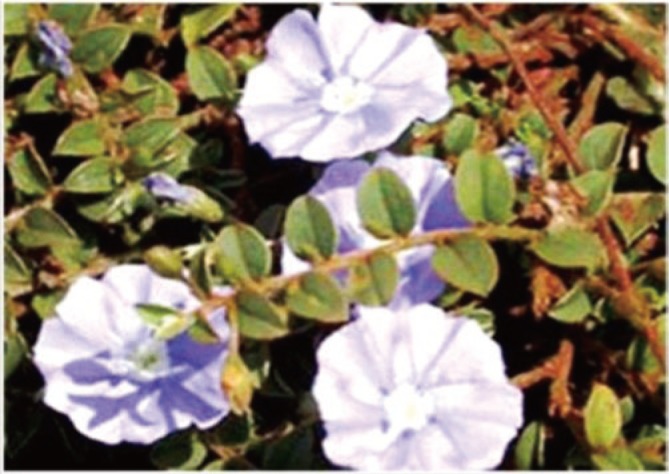
1.2. Scientific classification
The scientific classification of C. pluricaulis is demonstrated as follows[8]:
| Kingdom: | Plantae |
| Sub-kingdom: | Tracheobionta |
| Super-division: | Spermatophyta |
| Division: | Magnoliophyta |
| Class: | Magnoliopsida |
| Sub-class: | Asteridae |
| Order: | Solanales |
| Family: | Convolvulaceae |
| Genus: | Convolvulus |
| Species: | pluricaulis |
1.3. Vernacular names
The vernacular names of C. pluricaulis is described as follows:
| Sanskrit: | Sankhapuspa |
| Bengal: | Sankhapuspi |
| Gujarathi: | Shankhavali |
| Hindi: | Shankhapushpi, Aparajit |
| Kannada: | Bilikanthisoppu |
| Marathi: | Shankhavela |
| Punjabi: | Shankhapuspi |
| Tamil: | Sanghupushpam, kakkurattai |
| Telugu: | Shankhapushpi |
1.4. Description
C. pluricaulis is a perennial herb that seems like morning glory. Its branches are spread on the ground and can be more than 30 cm long. The flowers are blue in color (5 mm) and the leaves, which are elliptic in shape (2 mm), are located at alternate positions with branches or flowers. Known as Aloe weed in English, the herb is commonly found in India, especially in the state of Bihar[9].
1.5. Chemical constituents
The chemical constituents of C. pluricaulis are shown in Table 1[5].
Table 1. Chemical constituents of C. pluricaulis.
| Class | Chemical constituents |
| Carbohydrats | D-glucose, maltose, rhamnose, sucrose, starch and other carbohydrats |
| Proteins and amino acids | Proteins and amino acids |
| Alkaloids | Shankhapushpine, convolamine, convoline, convolidine, convolvine, confoline, convosine |
| Fatty acids/volatile acids/fixed oil | Volatile oils, fatty acids, fatty alcohols, hydrocarbons,myristic acids, palmitic acids and linoleic acids |
| Phenolic/glycosides/triterpenoids/steroids | Scopoletin, β-sitosterol, ceryl alcohols, 20-oxodotriacontanol, tetratriacontanoic acids, flavonoid-kampferol, steroids-phytosterols |
1.6. Medicinal importance of C. pluricaulis
C. pluricaulis is of various medicinal uses. It is used for treatment of hypertension, neurodegenerative diseases, ulcers, high blood pressure, epilepsy, vomiting, diabetes, sun stroke and bleeding. In addition, it can also be used to improve memory and decrease cholesterol[10].
1.7. Traditional uses
Many previous studies have reported the traditional uses of C. pluricaulis. This plant is reported to be a prominent memory improving drug, a psychostimulant and tranquilize, and reduce mental tension. There is a pertinent reference in Ayurvedic literature about the use of the drug as brain tonic in hypotensive syndromes. The pharmacological studies of the herb have shown varying degree of its hypotensive and tranquilizing effects. Clinical studies have exhibited demonstrable beneficial effects of C. pluricaulis on the patients of anxiety neurosis. The herb induces a feeling of calm and peace, good sleep and a relief in anxiety, stresses, mental fatigue, producing a significant reduction in the level of anxiety, neuroticism arising due to various levels of stresses. The herb appears to produce its action by modulation of neurochemistry of the brain. The plant improves the balance and vitiation in kapha-vata-pitta doshas, and the herb is astringent and bitter[11].
2. Macroscopic characters
Preliminary macroscopical characters of ethanolic extracts of C. pluricaulis (leaves) are given in Table 2[12].
Table 2. Preliminary macroscopical characters of ethanolic extracts of C. pluricaulis (leaves).
| C. pluricaulis | Characters | |
| Stem structures | Length | Several prostrate stems (10-30 cm) |
| Surface | Clothed with silky hairs | |
| Internodes | 10-12 mm | |
| Taste | Tasteless | |
| Leaf structures | Dimension | Length=1.12 cm; breadth=0.1 cm |
| Attachment | Leaf stalk absent | |
| Lamina | Thin | |
| Stipules | Exstipulated | |
| Leaf lamina shape | Linear | |
| Leaf margin | Entire | |
| Leaf apex | Acute | |
| Leaf base | Decurrent | |
| Leaf texture | Whole (brittle) | |
| Venation | Parallel | |
| Phyllotaxy | Alternate | |
| Leaf surface | Hairy | |
3. Microscopic characters
Preliminary microscopical characters of ethanolic extracts of C. pluricaulis (leaves) are given in Table 3[13].
Table 3. Preliminary microscopical characters of ethanolic extracts of C. pluricaulis (leaves).
| C. pluricaulis | Characters | |
| Stem structures | Outline in transverse section | Terete, wings absent |
| Cuticle | Straited | |
| Trichomes covering | Present, conical, unicellular | |
| Glandular | Present, stalk unicellular, head multicellular | |
| Chlorenchyma | Present | |
| Collenchyma | Present | |
| Endodermis | Indistinct | |
| Pericyclic fibers | Present | |
| Phloem fibers | Present | |
| Pith | Cells pitted in older stem | |
| Leaf structures | Outline in transverse section | Concave-convex |
| Collenchyma | Present beneath upper epidermis | |
| Calcium oxalate | Plenty, along veins | |
| Lamina | Isobilateral | |
| Cuticle | Straited | |
| Trichomes | Present | |
| Stomata | Both anisocytic and paracytic types on either side | |
| Stomata number | Upper surface | 202-216-238 |
| Lower surface | 188-223-251 | |
| Stomatal index | Upper surface | 16.9-18.0-17.2 |
| Lower surface | 14.8-16.3-17.2 | |
| Vein-islet number | 7.5-8.0-9.0 | |
| Extractive value | Water soluble | 18.21 |
| Alcohol soluble | 16.14 | |
4. Pharmacological activities
Preliminary pharmacological activities of ethanolic extracts of C. pluricaulis (leaves) are given in Table 4[14]–[29].
Table 4. Preliminary pharmacological activities of ethanolic extracts of C. pluricaulis (leaves).
| Activity | Plant part/extract | Dose/model | Standard Drug | Result |
| Antioxidant activity | Whole part/chloroform | 84%, 83%, 48%/DPPH model | Ascorbic acid | The C. pluricaulis extract possesses significant anticonvulsant activity when tested in vitro. |
| Antioxidant activity | Whole part/methanolic | 41 µg/mL/DPPH model | Ascorbic acid | The C. pluricaulis extract demonstrated significant free radical scavenging effect. |
| Anticonvulsant activity | Whole part/methanolic | 500, 1 000 mg/kg/MES model | Phenytoin | The C. pluricaulis extract at this dose didn't abolish the hind limb extension, but reduced the mean recovery time from convulsion. |
| Antidepressant activity | Whole part/ethanolic | 50, 100 mg/kg/TST and FST model | Imipramine or fluoxetine | The result showed that only chloroform fraction in this doses significantly reduced the immobility time in both FST & TST. |
| Anxiolytic activity | Aerial part/ethanolic | 200 mg/kg/EPM model | Diazepam | The result showed that ethyl acetate fractions at this dose reduced the neuromuscular co-ordination indicative of the muscle relaxant activity. |
| Anxiolytic activity | Flower part/ethanolic | 100, 200, 400 mg/kg/EPM model | Diazepam | The result demonstrated that the flower extract of plant exerted anxiolytic effect in mice on EPM. |
| Learning behavior and memory enhancement activity | Whole part/ethanolic | 100 mg/kg/passive avoidance paradigms and active avoidance test | Piracetam | The C. pluricaulis extract exhibited potent memory enhancing effects. |
| Learning behavior and memory enhancement activity | Root part/ethanolic | 200 mg/kg/passive avoidance paradigms and active avoidance test | Piracetam | The result shown that higher retension was observed with plant extract as compared with standard drug. |
| Anti thyroid activity | Root part/ethanolic | 0.4 mg/kg/radioimmumoassay technique | Methimazole | The result indicated that C. pluricaulis extract inducing inhibition in thyroid function was primarily mediated through T4 to T3 conversion. |
| Antiulcer activity | Whole part/ethanolic | 375, 750 mg/kg/gastric ulcer model | Sucralfate | The result was found due to augmentation of mucosal defensive factors like mucin secretion rather than acid pepsin. |
| Antiobsessive activity | Whole part/methanolic | 200, 400 mg/kg/rota rod, hole board test | Fluoxetine, diagepam | The result shown that C. pluricaulis extract can modulate serotonin or dopaminergic levels. |
| Neuroprotective activity | Whole part/aqueous | 150 mg/kg/EPM, MWM model | Rivastigmine tartrate | The result shown that when scopolamine is induced, the C. pluricaulis extract may exert its potent enhancing activity through anti-AChE and antioxidant action. |
| Neuroprotective activity | Whole part/aqueous | 150 mg/kg/ EPM, MWM model | Rivastigmine tartrate | The result shown that when aluminium chloride is induced, the C. pluricaulis extractpossesses neuroprotective potential, thus validating its use in alleviating toxic effects of aluminium. |
| Hepatoprotective activity | Leaves part/ethanolic | 200, 400, 600 mg/kg/ thioacetamide induced liver damage in rats | Silymarine | The result shown that C. pluricaulis extract possesses significant hepatoprotective property in thioacetamide induced liver toxicity in rat model. |
| Anti-bacterial activity | Whole part/methanolic | Escherichia coli ATCC 8739, Staphylococcus aureus 6538 / Cup plate Model | Tetracycline | The result shown that C. pluricaulis extract is more active against Escherichia coli in comparision to Staphylococcus aureus. |
| Antiviral activity | Whole part/aqueous | 150 mg/kg/scopolamine induced increased tau and amloid precursor protein | Rivastigmine | The result shown that C. pluricaulis extract reduced the increased protein and mRNA levels of tau and AβPP levels followed by reduction in Aβ levels compared with scopolamine treated group. |
| Nootropic activity | Whole part/ethanolic | 250, 500 mg/kg/Cook and Weidley's pole climbing model | Piracetam | The result shown that C. pluricaulis extract is less effective than other species of Shankhpuspi (Evolvulus alsinoides). |
DPPH: 1,1-diphenyl-2-picryl- hydrazyl, MES: maximal electro shock, TST: tail suspension test, FST: forced swim test, EPM: elevated plus maze, MWM: morris water maze, CNS: central nervous system, AβPP: amyloid precursor protein.
5. Phytochemistry
The preliminary phytochemical screening carried out on ethanolic extracts of C. pluricaulis (leaves) revealed the presence of phytoconstituents such as alkaloids, glycosides, flavonoids, carbohydrates, proteins, sterols, gum and mucilages compounds. Diverse pharmacological properties and structurally novel compounds have been found for the alkaloids, flavanoids, glycosides, and steroids in C. pluricaulis suggesting that these compounds may be the major contributors for the traditional therapeutical effects of C. pluricaulis. Other compounds such as proteins, gum and mucilages have been also reported in C. pluricaulis.
5.1. Physical analysis
The physical analysis of C. pluricaulis are given in Table 5[30].
Table 5. Physical analysis of C. pluricaulis.
| Parameters | Values |
| Foreign matter analysis | (1.1350±0.1407)% w/w |
| Loss on drying | (11.8500±0.7188)% w/w |
| Total ash | (7.1300±0.3371)% w/w |
| Acid insoluble ash | (3.9500±0.3905)% w/w |
| Water soluble ash | (1.9500±0.1528)% w/w |
| Swelling index | Absent |
| Foaming index | Less than 100 |
| Phosphate 1% solution | 7.22 |
| Phosphate 10% solution | 7.53 |
| Extractive value | Hot extraction (w/w) |
| Petroleum ether | (0.8000±0.0288)% |
| Chloroform | (0.9250±0.0866)% |
| Acetone | (1.0750±0.1507)% |
| Methanol | (2.0000±0.0803)% |
| Hydro-alcohol | (4.9750±0.3744)% |
| Aqueous | (16.9300±1.0760)% |
| Ethanol | (0.1189±0.0321)% |
5.2. Phytochemical test
The preliminary phytochemical test of ethanolic extracts of C. pluricaulis (leaves) are given in Table 6[31],[32].
Table 6. Preliminary phytochemical test of ethanolic extracts of C. pluricaulis (leaves).
| Phytochemical tests | Results |
| Test for alkaloids | + |
| Test for glycosides | + |
| Test for carbohydrates | + |
| Test for saponins | - |
| Test for fats and oils | - |
| Test for flavonoids | + |
| Test for tannis and phenolic compounds | - |
| Test for protein | + |
| Test for gums and mucilage | + |
| Test for steroids | + |
+: presence of compound; -: absence of compound.
5.3. Phytochemical structures
The phytochemical structures present in C. pluricaulis are given in Table 7[33],[34].
Table 7. Phytochemical structures present in C. pluricaulis.
| Chemical name | Structure | |
| D-glucose |
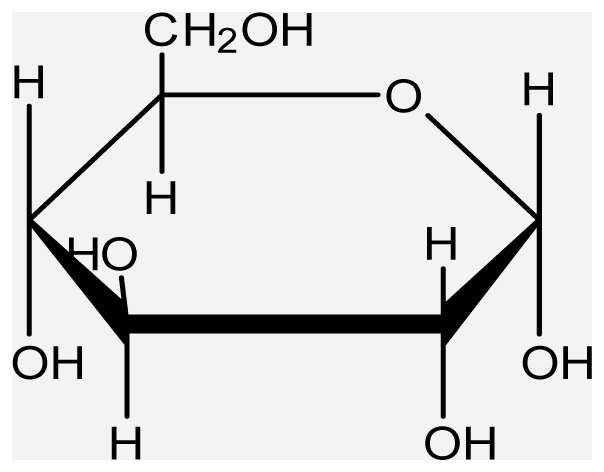 D-glucose is also known as dextrose or grape sugar. It is a simple monosaccharide found in the plants |
|
| Maltose |
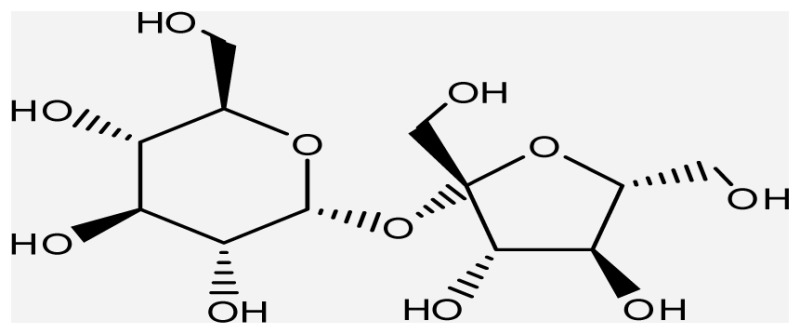 Maltose is also known as maltobiose or malt sugar, a disaccharide formed from two units of glucose joined with α bond |
|
| Rhamnose |
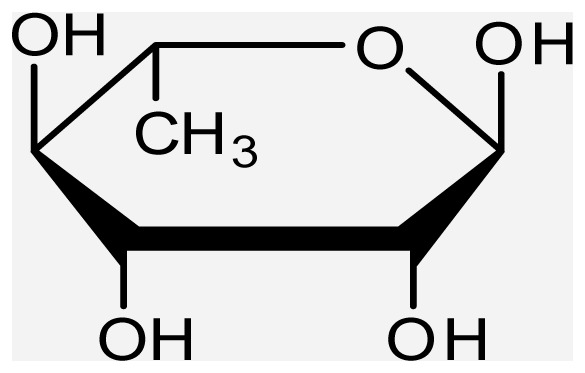 Rhamnose is a naturally occurring deoxy sugar |
|
| Sucrose | Sucrose is the organic compound commonly known as table sugar and sometimes called saccharose | |
| Convolvine |
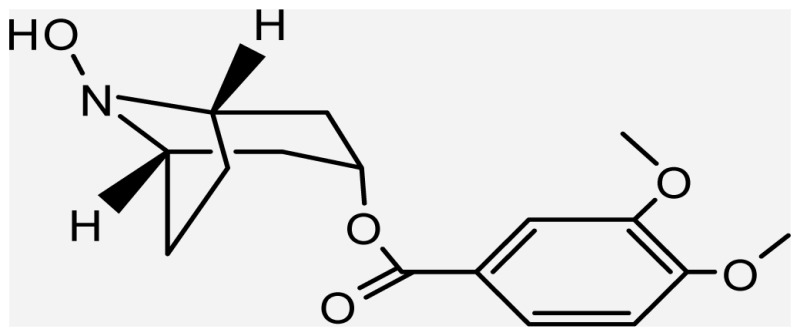 Convolvine is an alkaloid, present in the leaves and stem of this species |
|
| Starch |
 Starch or amylum is a carbohydrate consisting of a large number of glucose units joined by glycosidic bonds |
|
| convoline | 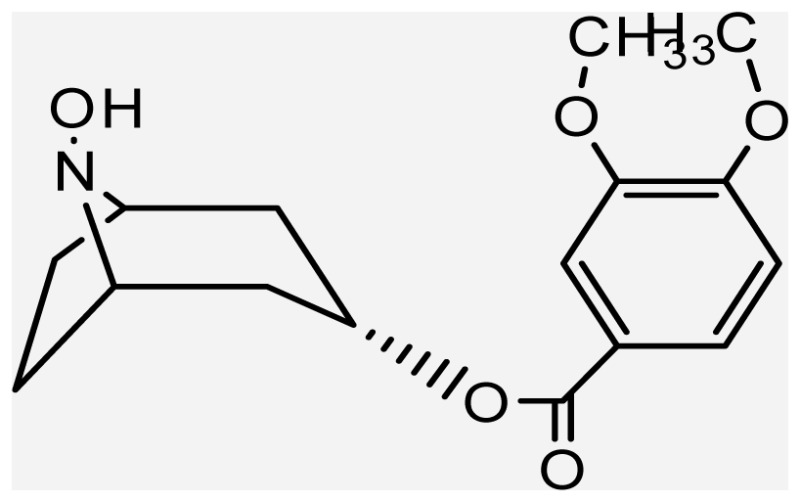 |
|
| Myristic acid |
 Myristic acid also called tetradecanoic acid, is a common saturated fatty acids |
|
| Palmitic acid |
 Palmitic acid also called hexadecanoic acid, is the most common fatty acid found in animals, plant and microorganism |
|
| Scopoletin |
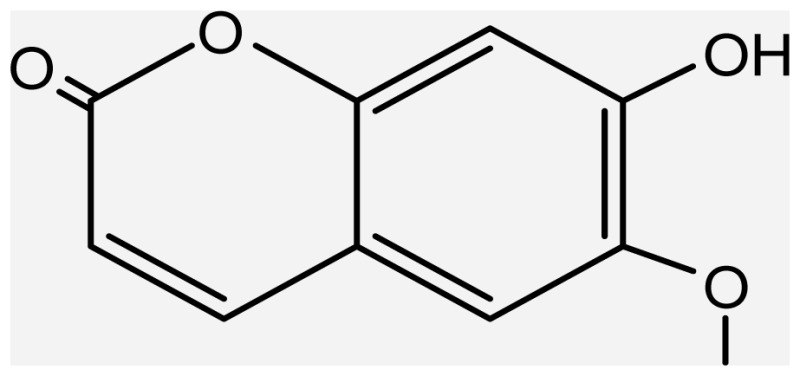 Scopoletin is a coumarin found in root of plants in the genus scopolia |
|
| Linoleic acid |
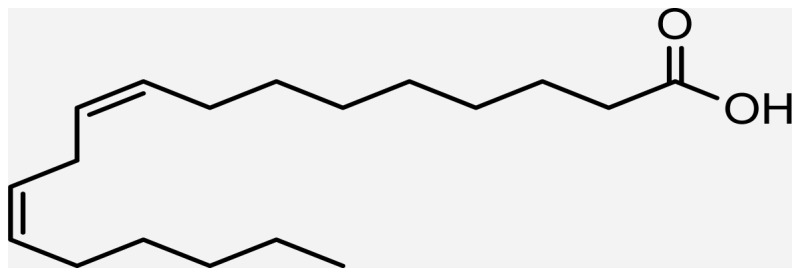 Linoleic acid belongs to one of the two families of esential fatty acids; it is an unsaturated n-6 fatty acid |
|
| Kampferol |
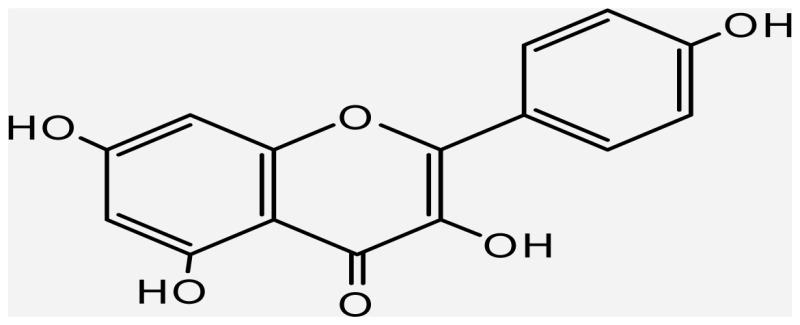 Kampferol is a natural flavonol, a type of flavonoid; kaempferol have a wide range of pharmacological activities, including antioxidant, anti-inflammatory, antimicrobial, anticancer, cardioprotective, neuroprotective, antidiabetic, anti-osteoporotic, estrogenic/antiestrogenic, anxiolytic, analgesic and antiallergic activities |
|
| β-sitosterol |
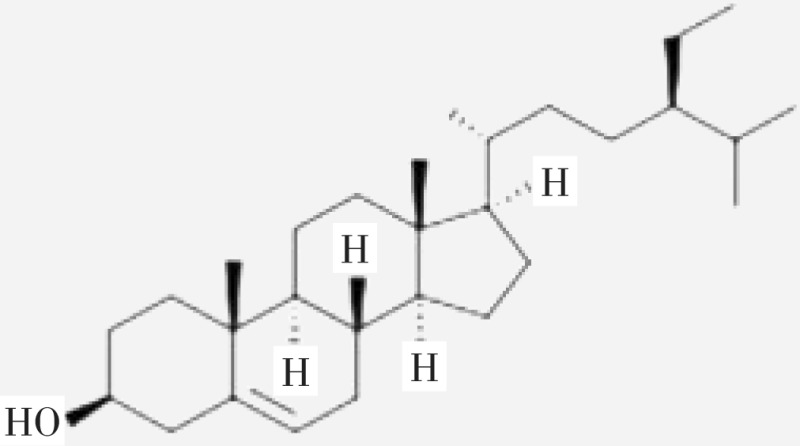 β-sitosterol is one of several phytosterols (plant sterols) with chemical structures similar to that of cholesterol. It is used in treating hypercholesterolemia |
|
| Cetyl alcohol |
 Cetyl alcohol, also known as 1- hexadecanol and palmityl alcohol, is a fatty alcohol |
|
6. Current Ayurvedic formulation
Many medicines are currently available in India, in which after mixing numerous plant extracts or powders with two or three Medhya plants including C. pluricaulis Ayurvedic formulation is developed[35]. Some preparations have been subjected to clinical trials. Examples include:
6.1. Remem (Zydus Industries, India)
The syrup and tablets include the following 10 species: Centella asiatica (C. asiatica), Celastrus paniculatus (C. paniculatus), C. pluricaulis, Asparagus racemosus (A. racemosus), Acorus calamus (A. calamus), Embelia ribes (E. ribes), Tinospora cordifolia, Achyrantes aspera, Terminalia chebula and Saussurea lappa[35].
6.2. Tirukati
Tirukati includes 13 species: Bacopa monnieri, C. pluricaulis, C. asiatica, A. racemosus, Valeriana wallichii, Rueraria tuberosa, Saussurea lappa, E. ribes, Tinospora cordifolia, Operculina turpethum, Pavonia odorata, Caryophyllus aromaticus and Foeniculum vulgare[35].
6.3. Ayumemo (Welexlabs, India)
Ayumemo consists of 5 species: C. asiatica, C. pluricaulis, C. paniculatus, Withania somnifera, and A. racemosus[35].
6.4. Abana (The Himalaya Drug and Co, India)
The syrup and tablets include 19 species: C. asiatica, C. pluricaulis, C. paniculatus, Balsamodedron mukul, Ocimum sanctum, Nardostachys jatamansi, Piper longum, Carum copticum, Zingiber officinalis, Cyperus rotundus, A. calamus, E. ribes, Syzygium aromaticum, Santalum album, Elettaria cardamomum, Foeniculum vulgare, Rosa damascena, Cinnamomum cassia and Crocus sativus[35].
6.5. Tejras (Sandu Brothers, India)
The syrup consists of the following 12 species: C. asiatica, C. pluricaulis, C. paniculatus, Eclipta alba, Cynodon dactylon, A. racemosus, Withania somnifera, Nardostachys jatamansi, A. calamus, Zingiber officinalis and Vetiveria zizanoides[35].
6.6. Shankhapushpi (Unjha Pharmacy, India)
The syrup includes 6 species: C. pluricaulis, C. asiatica, Nardostachys jatamansi, Nepeia hindostana, Nepeia elliptica and Onosma brateatum[35].
7. Toxicity
The LD50 of the whole extract of C. microphyllus by oral administration was found to be 1 250 (1 000-1 400) mg/kg. Mice treated with the extract showed a sedative effect at doses greater than 200 mg/kg and reflected a moderate to marked decrease in locomotor activity which lasted 1-2 h. The decrease in motor activity due to spontaneous motor activity was observed during the study. At a higher dose (more than 1 g/kg) animals died due to respiratory distress[36].
8. Conclusion
The present review discusses the plant profile, pharmacognosy, pharmacology, phytochemistry of the herb, C. pluricauli. Glycosides, flavonoids, alkaloids, carbohydrates, steroids, proteins, gums and mucilage compounds are commonly present in this species. Pharmacological studies carried out on crude extracts and pure metabolites provided pragmatic documents for its traditional uses, and have revealed this herb to be a valuable source for medicinally important molecules.
Acknowledgments
The authors are thankful to the authorities of Bundelkhand University Jhansi for providing support to the study and other necessary facility like internet surfing, library and other technical support to write a review article.
Comments
Background
This is a review paper on the benefits of C. pluricaulis as an alternative medicine for many diseases. The pharmacological effects exhibited by this plant have been elaborated in depth with citations from studies that have been conducted using this Ayurvedic plant.
Research frontiers
There is no lab experiment being done in this manuscript since it is a review paper. However, the author cited latest and recent publications on works done in this particular field, in which bring the readers to the recent analytical approach for pharmacological potential of this plant.
Related reports
The author cited different papers in his manuscript to support the therapeutic potential of C. pluricaulis in traditional medicine. Past studies mostly presented the pharmacological activities of this plant done in vitro and in vivo.
Innovations and breakthroughs
This review paper is one of its own in which it summarizes any research that have been conducted on C. pluricaulis specifically in medicinal field. It is a good source of literature survey for researchers who intended to do studies in this particular field, and use this plant.
Applications
This paper could be applied by most Ayurvedic practitioners in their medication activities to treat patients with different types of diseases.
Peer review
This paper is a good review paper on Ayurvedic and pharmacological activities of C. pluricaulis. Citations used are also a good resources for reviewing and very informative to all the Ayurvedic and traditional practitioners.
Footnotes
Foundation Project: Supported by Institute of Pharmacy, Bundelkhand University, Jhansi, U.P, India (Grant No. BU/PHARM/2013/1003).
Conflict of interest statement: We declare that we have no conflict of interest.
References
- 1.Fatima A, Agrawal P, Singh PP. Herbal option for diabetes: an overview. Asian Pac J Trop Dis. 2012;2(suppl 1):S536–S544. [Google Scholar]
- 2.Agarwal P, Alok S, Fatima A, Singh PP. Herbal remedies for neurodegenerative disorder (alzheimer's disease): a review. Int J Pharm Sci Res. 2013;4(9):3328–3340. [Google Scholar]
- 3.Ministry of Health and Family Welfare, Department of Indian Systems of Medicine and Homeopathy . The Ayurvedic Pharmacopoeia of India. New Delhi: Controller of Publications; 2001. [Google Scholar]
- 4.Gupta AK, Tandon N, Sharma M. Quality standards of Indian medicinal plants. New Delhi: Indian Council of Medical Research; 2005. [Google Scholar]
- 5.Sethiya NK, Nahata A, Mishra SH, Dixit VK. An update on Shankhpushpi, a cognition-boosting Ayurvedic medicine. Zhong Xi Yi Jie He Xue Bao. 2009;7(11):1001–1022. doi: 10.3736/jcim20091101. [DOI] [PubMed] [Google Scholar]
- 6.Dhingra D, Valecha R. Evaluation of the antidepressant-like activity of Convolvulus pluricaulis Choisy in the mouse forced swim and tail suspension tests. Med Sci Monit. 2007;13(7):BR155–161. [PubMed] [Google Scholar]
- 7.Flowers of India . India: Tabish; 2005. Flowers by botanical names-Convolvulus prostratus. [Online] http://www.flowersofindia.net/botanical.html. [Accessed on 14th November, 2013] [Google Scholar]
- 8.iloveindia.com . India: iloveindia.com; 2013. Shankapushpi. [Online] http://www.iloveindia.com/indian-herbs/shankapushpi.html. [Accessed on 8th Jully, 2013] [Google Scholar]
- 9.Kumar DC. Pharmacognosy can help minimize accidental misuse of herbal medicine. Curr Sci. 2007;93:1356–1358. [Google Scholar]
- 10.Dubey NK, Kumar R, Tripathi P. Global promotion of herbal medicine: India's opportunity. Curr Sci. 2007;86:37–41. [Google Scholar]
- 11.Bhowmik D, Kumar KPS, Paswan S, Srivatava S, Yadav A, Dutta A. Traditional Indian herbs Convolvulus pluricaulis Choisy and its medicinal importance. J Pharmacogn Phytochemistry. 2012;1(1):50–58. [Google Scholar]
- 12.Rasheeduz Z, Gandhi N. Practical Pharmacognosy. New Delhi: CBS Publisher & Distributor; 2007. [Google Scholar]
- 13.Sinha P, Kumar A, Wahi SP. A comparative pharmacognostic study on Shankhpuspi-Canscora decussate Schult., Convolvulus pluricaulis Choisy and Evolvulus alsinoides Linn. Bull Med Ethanobo Res. 1986;10:62–73. [Google Scholar]
- 14.Bihaqi SW, Sharma M, Singh AP, Tiwari M. Neuroprotective role of Convolvulus pluricaulis on aluminium induced neurotoxicity in rat brain. J Ethnopharmacol. 2009;124(3):409–15. doi: 10.1016/j.jep.2009.05.038. [DOI] [PubMed] [Google Scholar]
- 15.Verma S, Sinha R, Kumar P, Amin F, Jain J, Tanwar S. Study of Convolvulus pluricaulis for antioxidant and anticonvulsant activity. Cent Nerv Syst Agents Med Chem. 2012;12(1):55–59. doi: 10.2174/187152412800229161. [DOI] [PubMed] [Google Scholar]
- 16.Dhingra D, Valecha R. Screening for antidepressant-like activity of Convolvulus pluricaulis Choisy in mice. Pharmacologyonline. 2007;1:262–278. [PubMed] [Google Scholar]
- 17.Nahata A, Patil UK, Dixit VK. Anxiolytic activity of Evolvulus alsinoides and Convulvulus pluricaulis Choisy in rodents. Pharm Biol. 2009;47:444–451. [Google Scholar]
- 18.Sharma K, Arora V, Rana AC, Bhatnagar M. Anxiolytic effect of Convolvulus pluricaulis Choisy petals on elevated plus maze model of anxiety in mice. J Herbal Med Toxicol. 2009;3(1):41–46. [Google Scholar]
- 19.Sharma K, Bhatnagar M, Kulkarni SK. Effect of Convolvulus pluricaulis Choisy and Asparagus racemosus wild on learning and memory in young and old mice: a comparative evaluation. Indian J Exp Biol. 2010;48:479–485. [PubMed] [Google Scholar]
- 20.Nahata A, Patil UK, Dixit VK. Effect of Convulvulus pluricaulis Choisy on learning behaviour and memory enhancement activity in rodents. Nat Prod Res. 2008;22(16):1472–1482. doi: 10.1080/14786410802214199. [DOI] [PubMed] [Google Scholar]
- 21.Panda S, Kar A. Inhibition of T3 production in levothyroxine-treated female mice by the root extract of Convolvulus pluricaulis. Horm Metab Res. 2001;33(1):16–18. doi: 10.1055/s-2001-12620. [DOI] [PubMed] [Google Scholar]
- 22.Sairam K, Rao CV, Goel RK. Effect of Convolvulus pluricaulis Choisy on gastric ulceration and secretion in rats. Indian J Exp Biol. 2001;39(4):350–354. [PubMed] [Google Scholar]
- 23.Subramani R, Anand M, Muralidharan P. India: PharmaTutor EduLabs; 2008-2013. Effect of Convolvulus pluricaulis Choisy in obsessive compulsive disorder using animal models. [Online] http://www.pharmatutor.org/articles/effect-of-convolvulus-pluricaulis-in-obsessive-compulsive-disorder-using-animal-models. [Accessed on 28th July, 2013]. [Google Scholar]
- 24.Bihaqi SW, Singh AP, Tiwari M. In vivo investigation of the neuroprotective property of Convolvulus pluricaulis Choisy in scopolamine-induced cognitive impairments in Wistar rats. Indian J Pharmacol. 2011;43(5):520–525. doi: 10.4103/0253-7613.84958. [DOI] [PMC free article] [PubMed] [Google Scholar]
- 25.Bihaqi SW, Sharma M, Singh AP, Tiwari M. Neuroprotective role of Convolvulus pluricaulis Choisy on aluminium induced neurotoxicity in rat brain. J Ethnopharmacologicol. 2009;124(3):409–415. doi: 10.1016/j.jep.2009.05.038. [DOI] [PubMed] [Google Scholar]
- 26.Ravichandra VD, Ramesh C, Sridhar KA. Hepatoprotective potentials of aqueous extract of Convolvulus pluricaulis against thioacetamide induced liver damage in rats. Biomed Aging Pathol. 2013;3(3):131–135. [Google Scholar]
- 27.Verma S, Sinha R, Singh V, Tanwar S, Godara M. Antibacterial activity of methanolic extract of whole plant of Convolvulus pluricaulis Choisy. J Pharm Res. 2011;4(12):4450. [Google Scholar]
- 28.Bihaqi SW, Singh AP, Tiwari M. Supplementation of Convolvulus pluricaulis Choisy attenuates scopolamine-induced increased tau and amyloid precursor protein (AβPP) expression in rat brain. Indian J Pharmacol. 2012;44(5):593–598. doi: 10.4103/0253-7613.100383. [DOI] [PMC free article] [PubMed] [Google Scholar]
- 29.Kothiyal P, Rawat MS. Comparative nootropic effect of Evolvulus alsinoides and Convolvulus pluricaulis Choisy. Int J Pharma Bio Sci. 2011;2(1):616–621. [Google Scholar]
- 30.Verma S, Singh V, Tanwar S. Pharmacognostic validation of whole plant of Convolvulus pluricaulis Choisy (Convulvulaceae) Int J Pharm Pharm Sci. 2012;4:241–246. [Google Scholar]
- 31.Ministry of Health and Family Welfare . Pharmacopoeia of India. 3rd ed. New Delhi: Controller of Publications; 1985. [Google Scholar]
- 32.World Health Organization . The International Phamacopoeia. 3rd ed. Geneva: World Health Organization; 1994. [Google Scholar]
- 33.Lounasmaa M. The tropane alkaloids. In: Arnold Brossi., editor. The Alkaloids: Chemistry and Pharmacology. New York: Academic Press; 1988. [Google Scholar]
- 34.Kapadia NS, Acharya NS, Acharya SA, Shah MB. Use of HPTLC to establish a distinct chemical profile for Shankhpushpi and for quantification of scopoletin in Convolvulus pluricaulis Choisy and in commercial formulations of Shankhpushpi. J Planar Chromatography. 2006;19:195–199. [Google Scholar]
- 35.Sethiya NK, Mishra SH. Review on ethnomedicinal uses and phytopharmacology of memory boosting herb Convolvulus pluricaulis Choisy. Australian J Med Herbalism. 2010;22(1):19–25. [Google Scholar]
- 36.Pawar SA, Dhuley JN, Naik SA. Neuropharmacology of an extract derived from Convolvulus microphyllus. Pharm Biol. 2001;39:253–258. [Google Scholar]


